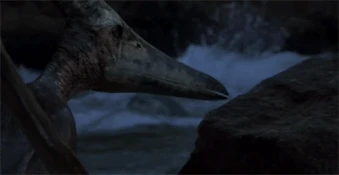Doobie Doo
Veteran
Seventy million years ago, a dragon-like creature ruled the skies above Mongolia. This pterosaur—a member of the order that includes pterodactyl—had the wingspan the size of a small plane, could launch off the ground in seconds, and may have even eaten baby dinosaurs.
Imagine a long-beaked monster, tall enough to see eye-to-eye with a giraffe, but flying through the sky. That is the animal that paleontologists have discovered, inferred from 5 pieces of neck bones found in the Nemegt formation of the Gobi Desert.

quetzalcoatlus
The skeleton of a Quetzalcoatlus hangs from the ceiling at the Texas Memorial Museum at the University of Texas, Austin. Kristin Hugo
Journal of Vertebrate Paleontology describes a “gigantic pterosaurian” known only from its enormous neck bones. While estimating the size and shape of an animal based only on cervical vertebrae is difficult, it was clear that they were similar to the vertebrae of other huge pterosaurs. Therefore paleontologists could infer that the animal was in the family Azhdarchidae, which includes Quetzalcoatlus. Quetzalcoatlus, which was discovered in 1971, had an estimated wingspan of 33 to 36 feet, or about as long as a telephone pole.
Quetzalcoatlus, making it among the largest animals to have ever flown. However, because only the neck vertebrae of one individual is known, they could have been smaller or larger on average. The huge neck vertebrae could indicate that the animal was proportionally larger than other azhdarchids. However, it’s also possible that it simply had a heavy, thick neck, disproportionate to the rest of its body. If it was much bigger than Quetzalcoatlus in total body size, it may have been too big to fly."
This newly-discovered animal was estimated to be of similar size to the famousQuetzalcoatlus, making it among the largest animals to have ever flown. However, because only the neck vertebrae of one individual is known, they could have been smaller or larger on average. The huge neck vertebrae could indicate that the animal was proportionally larger than other azhdarchids. However, it’s also possible that it simply had a heavy, thick neck, disproportionate to the rest of its body. If it was much bigger than Quetzalcoatlus in total body size, it may have been too big to fly.
The new animal does not yet have a name.
Flying Creature The Size of a Plane That Could Eat Baby Dinosaurs Discovered in Mongolia's Gobi Desert
Imagine a long-beaked monster, tall enough to see eye-to-eye with a giraffe, but flying through the sky. That is the animal that paleontologists have discovered, inferred from 5 pieces of neck bones found in the Nemegt formation of the Gobi Desert.

quetzalcoatlus
The skeleton of a Quetzalcoatlus hangs from the ceiling at the Texas Memorial Museum at the University of Texas, Austin. Kristin Hugo
Journal of Vertebrate Paleontology describes a “gigantic pterosaurian” known only from its enormous neck bones. While estimating the size and shape of an animal based only on cervical vertebrae is difficult, it was clear that they were similar to the vertebrae of other huge pterosaurs. Therefore paleontologists could infer that the animal was in the family Azhdarchidae, which includes Quetzalcoatlus. Quetzalcoatlus, which was discovered in 1971, had an estimated wingspan of 33 to 36 feet, or about as long as a telephone pole.
Quetzalcoatlus, making it among the largest animals to have ever flown. However, because only the neck vertebrae of one individual is known, they could have been smaller or larger on average. The huge neck vertebrae could indicate that the animal was proportionally larger than other azhdarchids. However, it’s also possible that it simply had a heavy, thick neck, disproportionate to the rest of its body. If it was much bigger than Quetzalcoatlus in total body size, it may have been too big to fly."
This newly-discovered animal was estimated to be of similar size to the famousQuetzalcoatlus, making it among the largest animals to have ever flown. However, because only the neck vertebrae of one individual is known, they could have been smaller or larger on average. The huge neck vertebrae could indicate that the animal was proportionally larger than other azhdarchids. However, it’s also possible that it simply had a heavy, thick neck, disproportionate to the rest of its body. If it was much bigger than Quetzalcoatlus in total body size, it may have been too big to fly.
The new animal does not yet have a name.
Flying Creature The Size of a Plane That Could Eat Baby Dinosaurs Discovered in Mongolia's Gobi Desert




 we dodged a bullet, imagine goin to the corner store and seein a nikka get scooped
we dodged a bullet, imagine goin to the corner store and seein a nikka get scooped 






